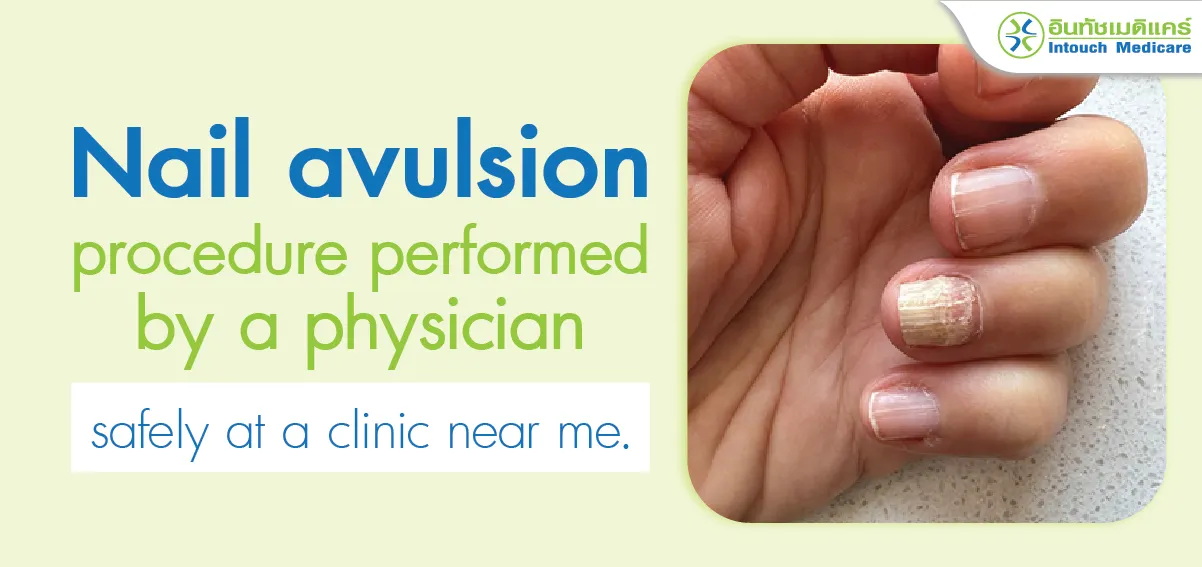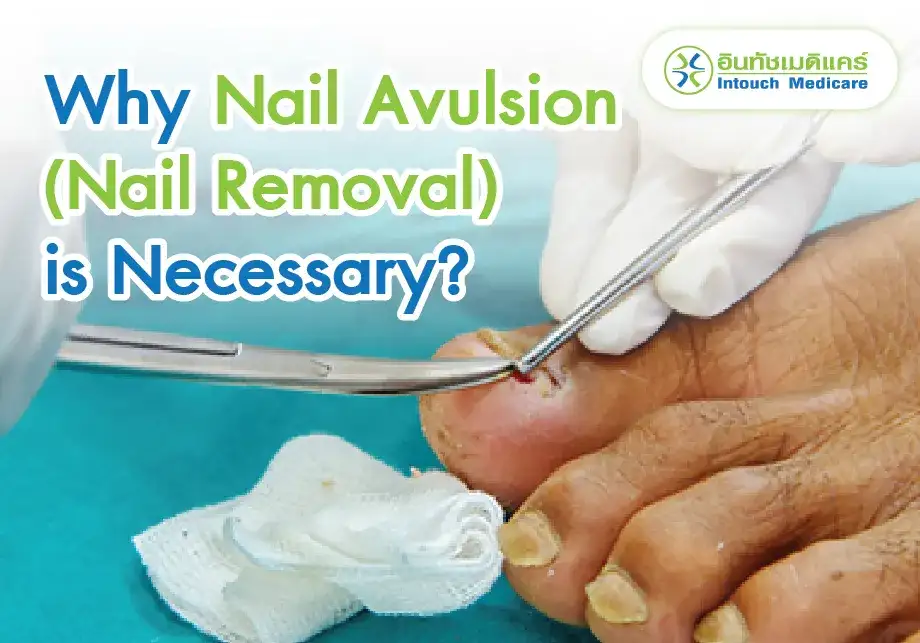Nail Avulsion (Nail Removal) Safe Procedure at a Clinic Near me

Nails are an essential part of protecting our fingers. If you experience any issues with your nails, such as tearing, detachment, breaking, ingrown nails, or fungal infections, it's important to see a doctor. They can assess whether the problematic nail should be removed to prevent further complications. The decision to perform a nail avulsion will depend on the specific symptoms and condition of the nail.
Topics on Nail Avulsion

Why is nail avulsion necessary?
The reason for nail avulsion is that a damaged nail can pose potential risks. Indications include severe pain from nail injury and accidents that prevent proper regrowth of the nail.
“Infections in the nail can lead to pus formation, more severe infections, or even chronic ingrown toenails.”
These issues can cause frequent pain and discomfort, making it difficult to wear shoes or carry out daily activities.
Read More: The Causes of Ingrown Toenails: Symptoms and Treatment by the Doctor
Can You Remove a Nail Yourself?
If anyone is wondering whether they can remove a nail themselves, doctors do not recommend it. There’s a risk of cutting the nail incorrectly, which could worsen the condition of an ingrown nail or any other issues, and in some cases, it could lead to nail tearing. If not done properly, it may result in the nail not growing back, cause an infection, or develop pus, which could become a serious issue.
“In cases I’ve encountered, I recommend that if the nail is about to come off, but the torn area has jagged edges, it’s best to see a doctor for an evaluation. In some cases, the entire nail may need to be removed, or in others, just the part that’s nearly detached can be cut away, followed by proper wound care. If unsure, you can come to see a doctor for an assessment.”![]()
Steps for Nail Avulsion by a Doctor
Positioning: Lie in a comfortable position, with the affected hand or foot placed in the designated procedure area.
Cleaning: The skin around the affected nail is cleaned with an antiseptic solution, alcohol, and saline.

Sterile Draping: A sterile drape with a hole is used to create a clean field for the procedure.
Anesthesia: Local anesthesia is injected at the base of the finger or toe to numb the entire area, preventing pain during the procedure.
Nail Removal Options:
Partial Nail Removal: This is done in cases of ingrown nails to reduce pressure on surrounding tissue.
Complete Nail Removal: Performed when the nail is severely damaged, such as in cases of significant tearing.
Nail Bed Repair: Depending on the injury, the nail bed may be repaired with sutures.
Wound Care: The wound is cleaned, treated with antiseptic, and covered with sterile gauze and waterproof plaster.


Self-care after nail removal
After the nail has been removed, you should follow these guidelines:
Make sure to attend dressing changes as scheduled by your doctor.
When sleeping, keep the affected foot elevated.
Apply ice to help reduce swelling.
Avoid getting the wound wet, damp, or exposed to moisture.

Take the medications prescribed by your doctor.
Avoid long-distance walking; refrain from sports activities for now.
Refrain from wearing tight shoes or those that squeeze the front of the foot.
Frequently Asked Questions About Nail Avulsion
Does it hurt to have a nail removed?
Answer: There will be pain only when the local anesthetic is injected.  After that, you will feel numbness in the finger or nail where the procedure was performed for about 2-3 hours. During the actual nail removal procedure, the patient should not experience pain.
After that, you will feel numbness in the finger or nail where the procedure was performed for about 2-3 hours. During the actual nail removal procedure, the patient should not experience pain.
Can I run after having a nail removed?
Answer: After having a toenail removed, it is recommended to avoid walking briskly or running for at least 2 weeks if possible. 
Can I play sports after having a nail removed?
Answer: If the nail removal was on the toe, you can engage in sports that do not involve sudden stops or running, such as basketball, soccer, tennis, or badminton. This is because sudden stops can cause pain in the area where the nail was removed and might also injure the new nail that is growing back.
How long does it take for a new nail to grow?
For fingernails: New nail growth typically takes about 6 months.
For toenails: The average time for a new toenail to grow is approximately 1 year.
Do I need to clean the wound daily after nail avulsion?
Answer: Ideally, you should clean the wound every day after nail avulsion. Regular wound inspection by a doctor or nurse is the best option. Generally, you can start to open the wound 24-48 hours after the procedure. After that, follow-up visits to check the wound every 1-2 days until it heals are recommended.
How many days after nail avulsion can the wound be exposed to water?
Answer: If you've recently had a nail removed, it's advised to avoid exposing the wound to water for at least 2 days after the wound is opened.
Is anesthesia used for nail avulsion?
Answer: Yes, anesthesia is necessary for nail avulsion. A local anesthetic is injected into the finger where the procedure is performed to prevent pain during the removal process. Without anesthesia, the patient would experience pain during the procedure.
A local anesthetic is injected into the finger where the procedure is performed to prevent pain during the removal process. Without anesthesia, the patient would experience pain during the procedure.
For more info and to make an appointment.
Hot Line 081-562-7722 Make a call
Composer: Panmai Premashthira, MD
Last edited : 23/09/2024
Images may be used without prior permission exclusively for educational or informational purposes, as long as proper credit is given to intouchmedicare.com



